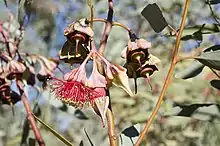| Wing-fruited mallee | |
|---|---|
 | |
| Eucalyptus alatissima in the Adelaide Botanic Garden | |
| Scientific classification | |
| Kingdom: | Plantae |
| Clade: | Tracheophytes |
| Clade: | Angiosperms |
| Clade: | Eudicots |
| Clade: | Rosids |
| Order: | Myrtales |
| Family: | Myrtaceae |
| Genus: | Eucalyptus |
| Species: | E. alatissima |
| Binomial name | |
| Eucalyptus alatissima | |
| Synonyms[2] | |
| |
Eucalyptus alatissima is a mallee that is endemic to central parts of the Great Victoria Desert. It has rough bark on the lower part of its stems, smooth tan to cream-coloured bark on its upper parts, egg-shaped to lance-shaped leaves and buds in groups of three. The buds have a powdery covering and are prominently winged.
Description
Eucalyptus alatissima is a multi-stemmed mallee, or occasionally a single-stemmed tree and typically grows to a height of 8 metres (26 ft). It has smooth, tan to cream bark on the upper parts and rough grey fibrous to ribbon-like bark toward the base. Leaves on young plants are egg-shaped to broadly lance-shaped, dull and bluish, usually with a powdery surface. The adult leaves are dull green to grey-green, egg-shaped to lance-shaped, 60–100 millimetres (2.4–3.9 in) long and 15–20 mm (0.6–0.8 in) wide.[3] The flowers are arranged in umbels of three in leaf axils. Mature flower buds are reddish, more or less spherical to oval, 32–45 millimetres (1.3–1.8 in) long and 15–30 mm (0.6–1.2 in) wide. Both the flower cup and operculum have a powdery covering and have prominent longitudinal wings, the operculum longer than the flower cup. It blooms between July and October producing inflorescences with pink to red or rarely yellow flowers. The fruit are woody capsules14–20 mm (0.55–0.79 in) long and 25–45 mm (0.98–1.77 in) wide with prominent longitudinally winged ridges. The fruits contain pyramidally shaped dark grey seeds that are 4 mm (0.16 in) long.[3][4][5][6]
Taxonomy
This eucalypt was first formally described in 1993 as Eucalyptus kingsmillii subsp. alatissima by the botanists Ian Brooker and Stephen Hopper in the journal Nuytsia.[7][8] In 2013 it was raised to species status by Dean Nicolle in his book Native eucalypts of South Australia.[9] The name of the species is commonly misapplied to Eucalyptus kingsmillii and Eucalyptus pachyphylla.[10] The specific epithet (alatissima) is the superlative form of the Latin word alatus meaning winged,[11]: 30 hence "most winged" or "very much so",[11]: 30 referring to the prominently winged buds and fruit.[3][4]
Distribution and habitat
This mallee grows in gravelly red sands and loam in mallee vegetation or mulga scrub near the South Australia-Western Australia border. It is found in central parts of the Great Victoria Desert between Vokes Hill in South Australia and Neale Junction east of Laverton in Western Australia. Its range includes parts of the Goldfields region.[3][5]
Conservation
Eucalyptus alatissima is classified as "not threatened" in Western Australia by the Western Australian Government Department of Parks and Wildlife.[5]
See also
References
- ↑ Fensham, R.; Laffineur, B.; Collingwood, T. (2019). "Eucalyptus alatissima". IUCN Red List of Threatened Species. 2019: e.T137618222A137618278. doi:10.2305/IUCN.UK.2019-3.RLTS.T137618222A137618278.en. Retrieved 20 September 2021.
- 1 2 "Eucalyptus alatissima". APC. Retrieved 24 February 2019.
- 1 2 3 4 "Eucalyptus alatissima (Myrtaceae) Wing-fruited Mallee". Seeds of South Australia. Government of South Australia. Retrieved 20 February 2019.
- 1 2 Nicolle, Dean (2013). Native Eucalypts of South Australia. Adelaide: Dean Nicolle. pp. 90–91. ISBN 9780646904108.
- 1 2 3 "Eucalyptus alatissima". FloraBase. Western Australian Government Department of Biodiversity, Conservation and Attractions.
- ↑ "Eucalyptus kingsmillii subsp. alatissima". Centre for Australian National Biodiversity Research. Retrieved 25 February 2019.
- ↑ "Eucalyptus kingsmillii subsp. alatissima". APNI. Retrieved 24 February 2019.
- ↑ Brooker, M. Ian; Hopper, Stephen D. (1993). "New series, subseries, species and subspecies of Eucalyptus (Myrtaceae) from Western Australia and from South Australia". Nuytsia. 9 (1): 38–39. Retrieved 24 February 2019.
- ↑ "Eucalyptus alatissima". APNI. Retrieved 24 February 2019.
- ↑ "Eucalyptus alatissima (Brooker & Hopper) D.Nicolle". Atlas of Living Australia. Global Biodiversity Information Facility. Retrieved 21 November 2017.
- 1 2 Brown, Roland Wilbur (1956). The Composition of Scientific Words. Washington, D.C.: Smithsonian Institution Press.
